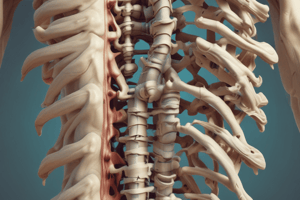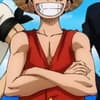Podcast
Questions and Answers
Which joint is the olecranon process most associated with?
Which joint is the olecranon process most associated with?
- Ball-and-socket joint
- Elbow (correct)
- Hip
- Wrist
What is the correct method to measure the length of the humerus?
What is the correct method to measure the length of the humerus?
- olecranon process to the styloid process of the radius
- acromion to the olecranon process (correct)
- greater trochanter to the medial malleolus
- suprasternal notch to the xiphoid process
What effect does curare have on muscle function?
What effect does curare have on muscle function?
- stimulates recruitment
- causes paralysis (correct)
- causes loss of sensation with no effect on motor activity
- induces tetanus
Which of the following statements about carpals is true?
Which of the following statements about carpals is true?
Recruitment in muscular contractions primarily increases what?
Recruitment in muscular contractions primarily increases what?
Which group is incorrect?
Which group is incorrect?
What is the site of calcium storage in a relaxed skeletal muscle?
What is the site of calcium storage in a relaxed skeletal muscle?
Which large muscle or muscle group extends the thigh at the hip?
Which large muscle or muscle group extends the thigh at the hip?
Which muscles are located between the ribs and help move the rib cage during breathing?
Which muscles are located between the ribs and help move the rib cage during breathing?
The orbicularis oris muscle primarily functions to:
The orbicularis oris muscle primarily functions to:
What is the purpose of myoglobin in muscle tissue?
What is the purpose of myoglobin in muscle tissue?
Which structure is the site of attachment for tendons?
Which structure is the site of attachment for tendons?
At which joint do the femur and tibia meet?
At which joint do the femur and tibia meet?
What is the outer lining of connective tissue that surrounds the diaphysis of a long bone and contains the blood vessels that supply the bone?
What is the outer lining of connective tissue that surrounds the diaphysis of a long bone and contains the blood vessels that supply the bone?
Which muscle lies along the anterior surface of the humerus and acts synergistically with the brachialis and brachioradialis to flex the forearm at the elbow?
Which muscle lies along the anterior surface of the humerus and acts synergistically with the brachialis and brachioradialis to flex the forearm at the elbow?
Which structure includes the calcaneus?
Which structure includes the calcaneus?
The olecranon process is most associated with which joint?
The olecranon process is most associated with which joint?
Which of the following is least true of the mandible?
Which of the following is least true of the mandible?
Which of the following does not refer to the thin filament?
Which of the following does not refer to the thin filament?
What is the term that refers to the replacement of cartilage by bone?
What is the term that refers to the replacement of cartilage by bone?
Fascicles are described as what?
Fascicles are described as what?
Which group contains incorrect information regarding the bones of the lower extremities?
Which group contains incorrect information regarding the bones of the lower extremities?
Which muscle flattens the cheek and positions food between the teeth?
Which muscle flattens the cheek and positions food between the teeth?
Which of the following bones is not located in the lower limbs?
Which of the following bones is not located in the lower limbs?
At which joint do the scapula and humerus meet?
At which joint do the scapula and humerus meet?
Which of the following muscles is primarily involved in raising the arms?
Which of the following muscles is primarily involved in raising the arms?
Which of the following describes both the hallux and pollex?
Which of the following describes both the hallux and pollex?
Flashcards
Olecranon process
Olecranon process
The olecranon process is a bony projection on the ulna bone located at the elbow joint. It forms the point of the elbow and is crucial for elbow extension.
Humerus length measurement
Humerus length measurement
The humerus is the long bone of the upper arm. It extends from the shoulder joint to the elbow joint.
Curare's effect on muscles
Curare's effect on muscles
Curare is a substance that blocks the receptors where the nerve and muscle meet, preventing the muscle from receiving the signal to contract.
What are the Carpals?
What are the Carpals?
Signup and view all the flashcards
Muscle recruitment
Muscle recruitment
Signup and view all the flashcards
Suture Joint
Suture Joint
Signup and view all the flashcards
Muscle Relaxation
Muscle Relaxation
Signup and view all the flashcards
Occipital Bone
Occipital Bone
Signup and view all the flashcards
Orbicularis Oris Muscle
Orbicularis Oris Muscle
Signup and view all the flashcards
Calcium Storage
Calcium Storage
Signup and view all the flashcards
Myoglobin
Myoglobin
Signup and view all the flashcards
The Maxilla
The Maxilla
Signup and view all the flashcards
Tibiofemoral Joint
Tibiofemoral Joint
Signup and view all the flashcards
Periosteum
Periosteum
Signup and view all the flashcards
Biceps brachii
Biceps brachii
Signup and view all the flashcards
Calcaneus
Calcaneus
Signup and view all the flashcards
Hamstrings
Hamstrings
Signup and view all the flashcards
Flexor carpi radialis and flexor carpi ulnaris
Flexor carpi radialis and flexor carpi ulnaris
Signup and view all the flashcards
Mandible
Mandible
Signup and view all the flashcards
Osteoblast, osteoclast, osteocyte, osseous tissue
Osteoblast, osteoclast, osteocyte, osseous tissue
Signup and view all the flashcards
Greater and Lesser Trochanters
Greater and Lesser Trochanters
Signup and view all the flashcards
Diaphysis
Diaphysis
Signup and view all the flashcards
Tendon
Tendon
Signup and view all the flashcards
Glenohumeral joint
Glenohumeral joint
Signup and view all the flashcards
Pectoralis major
Pectoralis major
Signup and view all the flashcards
Fascicles
Fascicles
Signup and view all the flashcards
Quadriceps femoris
Quadriceps femoris
Signup and view all the flashcards
Fontanels
Fontanels
Signup and view all the flashcards
Study Notes
Spinal Curvatures and Abnormal Curvatures
- Correct: Cervical, thoracic, lumbar, sacral are normal spinal curvatures.
- Correct: Scoliosis, kyphosis, lordosis are abnormal spinal curvatures.
Rib Types
- Correct: Ribs are categorized as true, false, and floating.
Freely Movable Joints
- Incorrect: Sutures are not freely movable joints. Free movable joints include hinge and ball-and-socket joints.
Muscle Relaxation
- Correct: Calcium is pumped back into the sarcoplasmic reticulum, causing muscle relaxation.
Occipital Bone
- Correct: The occipital bone contains the foramen magnum.
- Correct: The occipital bone is a cranial bone, not a facial bone.
Orbicularis Oris Muscle
- Correct: The orbicularis oris muscle surrounds the mouth.
Calcium Storage in a Relaxed Skeletal Muscle
- Correct: Sarcoplasmic reticulum is the site of calcium storage in a relaxed skeletal muscle.
Myoglobin Function
- Correct: Myoglobin stores oxygen in muscles.
- Correct: Myoglobin contributes to the red color of muscle.
Maxilla
- Correct: The maxilla contains the upper teeth.
- Correct: The maxilla is a facial bone, not a cranial bone.
Femur and Tibia Joint
- Correct: The femur and tibia meet at the tibiofemoral joint.
Thigh Extension Muscle
- Correct: Hamstrings extend the thigh at the hip joint.
Shoulder Covering Muscle
- Correct: The deltoid muscle covers the shoulder.
Gastrocnemius and Soleus Muscles
- Correct: Gastrocnemius and soleus are commonly called the "toe dancer's muscles".
Intercostal Muscles
- Correct: Intercostal muscles are located between the ribs and help in breathing.
Tendon Attachment Site
- Correct: Periosteum is the site of tendon attachment.
Palatine Process Bone
- Correct: The maxilla's palatine process forms the anterior part of the hard palate.
Diaphysis Outer Lining
- Correct: The periosteum is the outer lining of connective tissue that surrounds the diaphysis of a long bone, containing blood vessels.
Forearm Flexion Muscle
- Correct: The biceps brachii flexes the forearm at the elbow.
Calcaneus Location
- Correct: The calcaneus is a bone in the heel.
Olecranon Process Joint
- Correct: The olecranon process is associated with the humeroulnar joint.
Hamstring Muscles
- Correct: Biceps femoris, semitendinosus, and semimembranosus are the hamstring muscles.
Wrist Flexion Muscles
- Correct: Flexor carpi radialis and flexor carpi ulnaris flex the hand at the wrist.
Mandible Function
- Incorrect: The mandible articulates with the temporal bone.
- Correct: The mandible forms part of the TMJ.
Bone Cell Types and Tissue
- Correct: Osteoblast, osteoclast, osteocyte, and osseous tissue are related to bone.
Lower Extremity Bones
- Incorrect: The clavicle is in the upper extremity, not the lower.
Greater and Lesser Trochanters Bone
- Correct: The greater and lesser trochanters are on the femur.
Abdominal Muscles
- Incorrect: Hamstrings are not involved in breathing.
Long Bone Marking
- Incorrect: Suture is a type of joint, not a bone marking.
Cheek Muscle
- Correct: The buccinator muscle flattens the cheek and positions food.
Thin Filament Components
- Incorrect: Myosin is the thick filament, not the thin.
Occipital Bone Feature
- Incorrect: The mastoid process and external auditory meatus are associated with the temporal bone.
Cartilage Replacement
- Correct: Ossification is the process of cartilage replacement by bone.
Abdominal Muscle Groups
- Correct: Rectus, transversus, internal oblique, and external oblique are abdominal muscles.
Acetylcholine Release Trigger
- Correct: The nerve impulse triggers the release of acetylcholine.
Diaphysis Definition
- Correct: The diaphysis is the shaft of a long bone.
Tendon Structure
- Correct: Tendon attaches muscle to bone; an aponeurosis is a broad, flat tendon.
Scapula and Humerus Joint
- Correct: Scapula and humerus connect at the glenohumeral joint.
Anterior Chest Muscle
- Correct: Pectoralis major is the anterior chest muscle that helps point towards objects in front.
Joint Types
- Correct: Tibiofemoral, hip, and glenohumeral are freely movable, ball-and-socket joints. Humeroulnar is a hinge joint.
Fascicle Definition
- Correct: Bundles of muscle fibers are fascicles, bound by connective tissue.
Quadriceps Femoris Muscles
- Incorrect: The quadriceps femoris are extensors of the knee, not flexors.
- Correct: Rectus femoris, vastus lateralis, vastus medialis, and vastus intermedius are the quadriceps femoris muscles.
Baby's Skull Soft Spots
- Correct: Fontanels are soft spots in a baby's skull.
Scapula and Humerus Joint
- Correct: The shoulder joint (glenohumeral) connects the scapula and humerus.
Upper Extremity Bones
- Incorrect: Clavicle is a bone in the upper extremity
Scarecrow Muscle
- Correct: Trapezius is engaged when mimicking a scarecrow.
Hallux and Pollex Features
- Correct: They are both the first digits (big toe and thumb).
Lower Limb Bone
- Incorrect: Ulna is an upper limb bone.
Olecranon Process Joint
- Correct: The olecranon process is related to the elbow joint (humeroulnar).
Humerus Measurement
- Incorrect: Details for proper humerus measurement are not provided here.
Curare Effect
- Correct: Curare-induced muscle blockade causes paralysis.
Carpal Bones
- Correct: Carpals are wrist bones, and they articulate with the radius and ulna.
Muscle Contraction Enhancement
- Incorrect: Additional details for recruitment are not given.
Studying That Suits You
Use AI to generate personalized quizzes and flashcards to suit your learning preferences.





